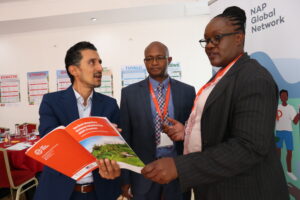World Animal Protection and World Cetacean Alliance have today launched a new global programme, working with a coalition of responsible travel businesses and wildlife charities, which they hope will change the way people travel to see wildlife forever.
Called ‘Wildlife Heritage Areas’ the programme will provide outstanding and responsible wildlife tourism experiences. Wildlife Heritage Areas has been developed to meet an expanding need from tourists to see wildlife in the wild, as the ethics of wild animals in zoos and aquariums increasingly comes under scrutiny. Now, travellers will be able to discover destinations where local communities care for and protect the wildlife in their environment and support them through incredible tourism experiences that are sustainable in the long-term.
Angela Maldonado, founder of Entropika, a conservation NGO and part of the Wildlife Heritage Network, comments: “The Amazon Night Monkey Heritage Area covers 640 km2 in Vista Alegre on the Colombian-Peruvian border. It offers low-impact nature activities, such as jungle hikes, wildlife watching tourism and experiential tourism, which are all guided by knowledgeable locals. These local stewards of the forest are critically important in helping to alleviate outside pressure that the monkeys face from a range of issues including trafficking for biomedical research and deforestation.”
Another example is The Apennines Marsican Bear Heritage Area in Italy, which covers 1100 km2 and focuses on the critically endangered Marsican brown bear, which is a central part of local history and culture, inspiring wildlife watchers to focus on the vibrant and dynamic landscape elements.
Dylan Walker, Wildlife Heritage Areas, said: “We believe Wildlife Heritage Areas will benefit both the local community and wildlife in responsible wildlife watching destinations. By working in partnership with locals, charitable and responsible tourism experts, we can showcase how culture, responsible tourism, and ideas for coexistence can create a better future for places, nature, and people.”
The travel industry currently has no means of identifying destinations meeting high standards of responsible wildlife watching. The Wildlife Heritage Area programme changes this.
Nick Stewart, Wildlife Campaign Director – World Animal Protection, said: “We’re delighted to have co-founded Wildlife Heritage Areas as a solution to exploitative wildlife tourism. We invite travel companies around the world to drop the elephant rides, ditch the dolphin shows and any of the other demeaning wildlife entertainment experiences out there and instead, get behind truly responsible wildlife tourism that meets the needs of local communities, visitors and of course wild animal welfare.”
In addition, Wildlife Heritage Areas will create new opportunities for visitors to engage with the unique culture, heritage and biodiversity that underpins each local community’s wildlife offering. This will help to generate pride and income for the responsible protection of wildlife and habitats.
Harry Eckman, CEO, World Cetacean Alliance, said: “Wildlife Heritage Areas are an exciting and perfect evolution of the WCA’s successful Whale Heritage Area program. Wildlife Heritage Areas will provide the communities with a unique opportunity to showcase and celebrate their heritage and connection to amazing species and environments and will provide tourists with an incredible opportunity to experience wildlife in the most inspiring ways.”
Current Wildlife Heritage Areas
- Plettenberg Bay Whale Heritage Area (designated), South Africa
- Algoa Bay Whale Heritage Area (designated), South Africa
- Amazon Night Monkey Heritage Area (candidate), Peru/Colombia
- Amazon Uakari Heritage Area (candidate), Brazil
- Apennines Marsican Bear Heritage Area (candidate), Italy
- Whitsundays Whale Heritage Area (Candidate) Australia
- Santa Barbara Channel Whale Heritage Area (new designation), USA
- Madeira Whale Heritage Area (new designation), Portugal
Candidate means the applicant has reached level 2 of 3 of the designation process.
Designated means the applicant has reached level 3 of 3 of the designation process.
New designation means that the application has newly reached level 3 of the application process.












